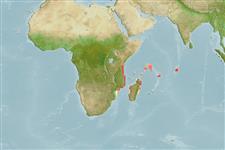>
Ovalentaria/misc (Various families in series Ovalentaria) >
Pseudochromidae (Dottybacks) > Pseudoplesiopinae
Etymology: Chlidichthys: Greek, chlidos, -eos, ous = collar, bracelet, adornment + Greek, ichthys = fish (Ref. 45335).
More on author: Smith.
Environment: milieu / climate zone / depth range / distribution range
Ecologie
marien rifbewoner; diepte 8 - 11 m (Ref. 88695). Tropical; 3°S -
Western Indian Ocean: Kenya to Mozambique, Aldabra I. and Socotra Archipelago.
Grootte / Gewicht / Leeftijd
Maturity: Lm ? range ? - ? cm
Max length : 6.1 cm TL mannelijk / geslacht onbekend; (Ref. 5471)
Korte beschrijving
Determinatiesleutels | Morfologie | Morfometrie
Dorsale stekels (totaal) : 2; Dorsale zachte stralen (totaal) : 23 - 25; Anale stekels: 3; Anale zachte stralen: 14 - 15.
Found among corals and seagrasses (Ref. 9710); and around a large boulder in a macroalgae dominated biotope, mixed with large sponges and sparse encrusting hard corals on rock platform (Ref. 88695).
Levenscyclus en paargedrag
Maturiteit | Voortplanting | Paaien | Eieren | Fecunditeit | Larven
Smith, M.M., 1986. Pseudochromidae. p. 539-541. In M.M. Smith and P.C. Heemstra (eds.) Smiths' sea fishes. Springer-Verlag, Berlin. (Ref. 5471)
Status op de Rode Lijst van het IUCN (Ref. 130435: Version 2024-1)
Gevaar voor de mens
Harmless
Gebruik door de mens
Tools
Speciale rapporten
Download XML
Internetbronnen
Estimates based on models
Fylogenetische diversiteitsindex (Ref.
82804): PD
50 = 0.5001 [Uniqueness, from 0.5 = low to 2.0 = high].
Bayesian length-weight: a=0.00447 (0.00174 - 0.01147), b=3.10 (2.87 - 3.33), in cm total length, based on LWR estimates for this (Sub)family-body shape (Ref.
93245).
Trofisch niveau (Ref.
69278): 3.4 ±0.5 se; based on size and trophs of closest relatives
Fishing Vulnerability (Ref.
59153): Low vulnerability (10 of 100).
